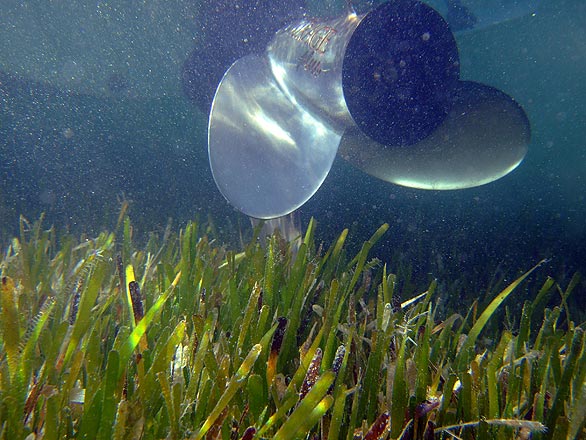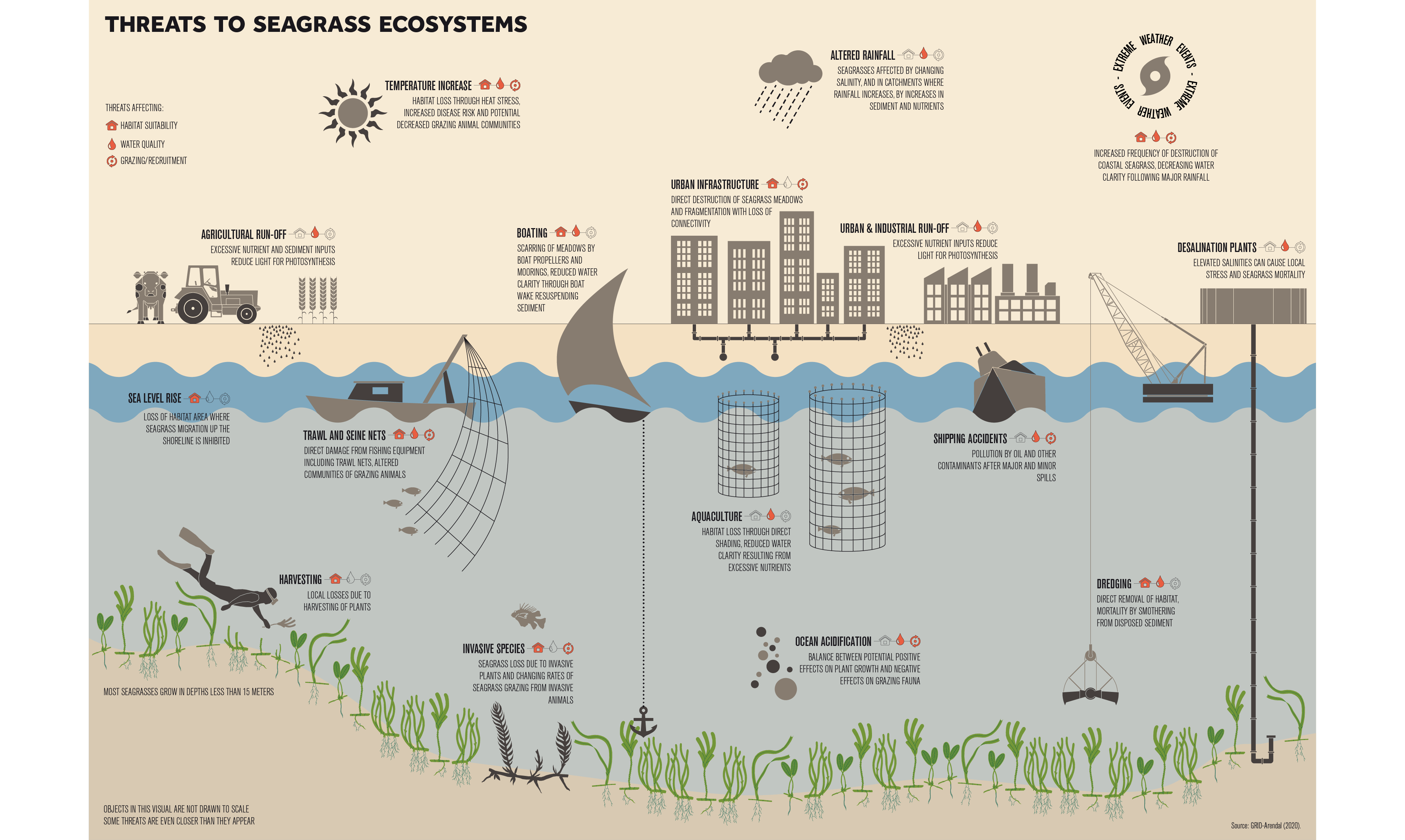Uncovering a Major Threat to Seagrass: Why Should We Care?

Boat propellors can damage seagrass (Photo Credit : Marine Joe Cavaretta/South Florida Sun Sentinel, State of Florida)
Seagrass, one of the marine ecosystems that is often forgotten, turns out to have a big role in maintaining the balance of the coastal environment. Seagrass is a flowering plant that lives in shallow marine environments. Unlike algae or algae, seagrass has roots, stems, and leaves like land plants. Seagrass ecosystems are widespread in tropical and subtropical waters, including in Indonesia, and have a wide range of ecological benefits:

The importance of seagrass (Photo Credit : Wildlife Conservation Society Tanzania)
- Sequestering Carbon: Seagrass acts as a blue carbon sink (blue carbon), storing large amounts of carbon that help reduce the impact of climate change (Dahl et al., 2023).
- Habitat and Shelter: Many marine species such as fish, mollusks, and green turtles rely on seagrass as a breeding and foraging ground.
- Prevents Coastal Erosion: Seagrass roots help to hold sediment and protect the coastline from abrasion caused by waves and ocean currents.
- Maintaining the Balance of Marine Ecosystems: Seagrass plays a role in maintaining the clarity of the water and is an indicator of the health of the marine environment.
However, various threats from human activities and climate change are now threatening its existence. A recent study reveals how the cumulative risks of various threats must be taken into account to protect seagrass ecosystems at scale. Threats to seagrass ecosystems are caused by various factors.

Threats to seagrass ecosystems (Photo Credit : Hisham Ashkar)
- Destructive Human Activities
The biggest threat to seagrass is human activity. Some of the main factors that contribute to seagrass degradation include:
- Pollution from Land: Industrial, agricultural, and household wastes that contain excess nutrients can lead to algae overgrowth (eutrophication), which blocks the entry of light to the seafloor and inhibits seagrass photosynthesis.
- Coastal Dredging and Development: Port construction, coastal reclamation, and sediment dredging activities can directly damage seagrass habitats.
- Boats: Heavy boat traffic can cause physical damage to seagrass due to anchoring and water turbulence that scatters sediment.
- Unsustainable Fisheries: The use of destructive fishing gear such as tiger trawls can damage seagrass habitats.
- Climate Change and Its Impacts/span>
In addition to human activities, climate change is also a major threat to seagrass:
- Rising Ocean Temperatures: Rising ocean temperatures can cause thermal stress on seagrass, stunt growth, and even lead to mass deaths.
- Sea Level Rise: As sea levels rise, seagrass habitats can sink deeper, reducing the intensity of light received and inhibiting photosynthesis.
- Increased Storm Intensity: Climate change is causing more frequent and powerful storms, increasing the rate of erosion and damaging seagrass habitats.
- Changes in Rainfall Patterns: More intense rainfall can increase sediment runoff from land to sea, causing turbidity that inhibits seagrass growth.
Study from McMahon et al. (2022) using a Cumulative Risk Analysis-based approach to evaluate threats to seagrass on a continental scale. The study not only looked at one threat in isolation, but combined a variety of factors to understand how they interact and impact the seagrass ecosystem as a whole.
Some of the key findings from their study include:
- High-Risk Hotspots: Areas with high population density, industrial activity, and intensive agriculture have the highest level of risk to seagrass.
- Future threats: If no mitigation measures are taken, risks from climate change could increase dramatically, exacerbating seagrass conditions already stressed by human activities.
- Different Management Impacts in Each Region: In some regions, reducing nutrient and sediment pollution can significantly lower the risk, while in others the main threats come from climate change factors that require different approaches.
Conservation and Sustainable Management
Based on the findings of this study, there are several steps that can be taken to protect seagrass:
- Reducing Pollution from Land:
- Improve the waste treatment system so as not to pollute the sea.
- Encourage more environmentally friendly agricultural practices to reduce fertilizer runoff into the sea.
- Protecting Seagrass Habitat:
- Limiting dredging and reclamation activities in coastal areas that have seagrass ecosystems.
- Establish marine conservation areas that protect seagrass beds from human disturbance.
- Management of Tourism and Fisheries Activities:
- Arrange the ship's path and anchor location so as not to damage the seagrass.
- Implement fisheries regulations that prohibit the use of destructive fishing gear.
- Addressing the Impact of Climate Change:
- Encourage seagrass restoration efforts by replanting seagrass in degraded areas.
- Include seagrass conservation in climate change mitigation policies, considering the role of seagrass as a blue carbon sink.
Conclusion
Various threats to seagrass must be viewed comprehensively and not separately. By using a cumulative risk-based approach. Seagrass protection requires a broader strategy, which includes waste management, sustainable fisheries, habitat conservation, and climate change mitigation.
As one of the countries with the largest seagrass diversity in the world, Indonesia has a great responsibility in this conservation effort. The steps we take today will determine the sustainability of seagrass ecosystems in the future.
-Yuni Sulaiman
References
Dahl, M., McMahon, K., Lavery, P. S., Hamilton, S. H., & ... (2023). Ranking the risk of CO2 emissions from seagrass soil carbon stocks under global change threats. In Global Environmental .... Elsevier. https://www.sciencedirect.com/science/article/pii/S0959378022001704
McMahon, K., Kilminster, K., Canto, R., Roelfsema, C., Lyons, M., Kendrick, G. A., Waycott, M., & Udy, J. (2022). The Risk of Multiple Anthropogenic and Climate Change Threats Must Be Considered for Continental Scale Conservation and Management of Seagrass Habitat. Frontiers in Marine Science, 9(March), 1–15. https://doi.org/10.3389/fmars.2022.837259

